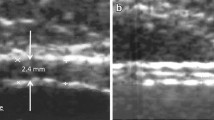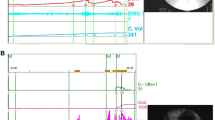Abstract
Purpose
To investigate whether circulating adiponectin, which is considered a possible marker of anti-atherogenic effects, is a useful predictor of bladder function, especially detrusor underactivity (DU), in men with lower urinary tract symptoms (LUTS).
Methods
A total of 130 treatment-naïve men with non-neurogenic LUTS were prospectively stratified into two groups (the DU and non-DU groups) based on the presence or absence of DU, where DU is defined as a bladder contractility index < 100 and bladder outlet obstruction index (BOOI) < 40. The impact of serum adiponectin levels on urodynamic function, including DU, was assessed using univariate, binomial logistic regression, and receiver operating characteristic (ROC) curve analyses.
Results
In total, data from 118 men were analyzed; 39 (33.0%) had DU (DU group) and 79 (67.0%) did not have DU (non-DU group). The median serum adiponectin in the DU group was significantly lower than in the non-DU group (6.2 vs 12.6 µg/mL, p < 0.001). In the binomial logistic regression analysis, lower adiponectin, smaller intravesical prostatic protrusion, and lower bladder voiding efficiency were significant factors related to DU. In the ROC analyses, serum adiponectin had the highest area under the curve value for DU diagnosis (0.849). Additionally, a cutoff value of 7.9 µg/mL for serum adiponectin level was identified for DU, which yielded a sensitivity and specificity of 79% and 90%, respectively.
Conclusions
The serum adiponectin level was significantly associated with bladder function and may be a useful marker for predicting DU in men with LUTS.

Similar content being viewed by others
Data availability
The datasets generated and/or analyzed during the current study are available from the corresponding author on reasonable request.
Abbreviations
- BCI:
-
Bladder contractility index
- BMI:
-
Body mass index
- BOO:
-
Bladder outlet obstruction
- BOOI:
-
Bladder outlet obstruction index
- BPE:
-
Benign prostatic enlargement
- BVE:
-
Bladder voiding efficiency
- DO:
-
Detrusor overactivity
- DU:
-
Detrusor underactivity
- FDV:
-
First desire to void
- HL:
-
Hyperlipidemia
- HT:
-
Hypertension
- IPP:
-
Intravesical prostatic protrusion
- IPSS:
-
International prostate symptom score
- LUTS:
-
Lower urinary tract symptoms
- MCC:
-
Maximum cystometric capacity
- MetS:
-
Metabolic syndrome
- OAB:
-
Overactive bladder symptom
- OABSS:
-
Overactive bladder symptom score
- PdetQmax:
-
Detrusor pressure at maximum flow rate
- PFS:
-
Pressure flow study
- PVR:
-
Post-void residual urine volume
- Qmax:
-
Maximum flow rate
- QOL:
-
Quality of life
- ROC:
-
Receiver operating characteristic
References
Osman NI, Chapple CR, Abrams P et al (2014) Detrusor underactivity and the underactive bladder: a new clinical entity? A review of current terminology, definitions, epidemiology, aetiology, and diagnosis. Eur Urol 65:389–98
Osman NI, Esperto F, Chapple CR (2018) Detrusor underactivity and the underactive bladder: a systematic review of preclinical and clinical studies. Eur Urol 74:633–643
Abrams P, Cardozo L, Fall M et al (2002) The standardisation of terminology of lower urinary tract function: report from the standardisation sub-committee of the international continence society. Neurourol Urodyn 21:167–178
Malde S, Nambiar AK, Umbach R et al (2017) Systematic review of the performance of noninvasive tests in diagnosing bladder outlet obstruction in men with lower urinary tract symptoms. Eur Urol 71:391–402
Tan YG, Teo JS, Kuo TLC, Guo L et al (2021) A systemic review and meta-analysis of transabdominal intravesical prostatic protrusion assessment in determining bladder outlet obstruction and unsuccessful trial without catheter. Eur Urol Focus S2405–4569(21):00245–00255
Ponholzer A, Temml C, Wehrberger C, Marszalek M, Madersbacher S (2006) The association between vascular risk factors and lower urinary tract symptoms in both sexes. Eur Urol 50:581–586
Smith DP, Weber MF, Soga K et al (2014) Relationship between lifestyle and health factors and severe lower urinary tract symptoms (LUTS) in 106,435 middle-aged and older Australian men: population-based study. PLoS One 9:e109278
Pashootan P, Ploussard G, Cocaul A, de Gouvello A, Desgrandchamps F (2015) Association between metabolic syndrome and severity of lower urinary tract symptoms (LUTS): an observational study in a 4666 European men cohort. BJU Int 116:124–130
Matsumoto S, Kakizaki H (2012) Causative significance of bladder blood flow in lower urinary tract symptoms. Int J Urol 19:20–25
Pinggera GM, Mitterberger M, Steiner E et al (2008) Association of lower urinary tract symptoms and chronic ischemia of the lower urinary tract in elderly women and men: assessment using colour Doppler ultrasonography. BJU Int 102:470–474
Yamaguchi O, Nomiya M, Andersson KE (2014) Functional consequences of chronic bladder ischemia. Neurourol Urodyn 33:54–58
Nomiya M, Yamaguchi O, Andersson KE et al (2012) The effect of atherosclerosis-induced chronic bladder ischemia on bladder function in the rat. Neurourol Urodyn 31:195–200
Azadzoi KM, Tarcan T, Siroky MB, Krane RJ (1999) Atherosclerosis-induced chronic ischemia causes bladder fibrosis and non-compliance in the rabbit. J Urol 161:1626–1635
Funahashi T, Nakamura T, Shimomura I et al (1999) Role of adipocytokines on the pathogenesis of atherosclerosis in visceral obesity. Intern Med 38:202–206
Ouchi N, Parker JL, Lugus JJ, Walsh K (2011) Adipokines in inflammation and metabolic disease. Nat Rev Immunol 11:85–97
Matsuzawa Y (2006) Therapy insight: adipocytokines in metabolic syndrome and related cardiovascular disease. Nat Clin Pract Cardiovasc Med 3:35–42
Yamauchi T, Kamon J, Waki H, Terauchi Y et al (2001) The fat-derived hormone adiponectin reverses insulin resistance associated with both lipoatrophy and obesity. Nat Med 7:941–946
Yamauchi T, Kamon J, Waki H et al (2003) Globular adiponectin protected ob/ob mice from diabetes and ApoE-deficient mice from atherosclerosis. J Biol Chem 278:2461–2468
Shibata R, Sato K, Pimentel DR et al (2005) Adiponectin protects against myocardial ischemia-reperfusion injury through AMPK- and COX-2-dependent mechanisms. Nat Med 11:1096–1103
Pischon T, Girman CJ, Hotamisligil GS, Rifai N, Hu FB, Rimm EB (2004) Plasma adiponectin levels and risk of myocardial infarction in men. JAMA 291:1730–1737
Nilsson PM, Engström G, Hedblad B et al (2006) Plasma adiponectin levels in relation to carotid intima media thickness and markers of insulin resistance. Arterioscler Thromb Vasc Biol 26:2758–2762
Schäfer W, Abrams P, Liao L et al (2002) Good urodynamic practices: uroflowmetry, filling cystometry, and pressure-flow studies. Neurourol Urodyn 21:261–274
Nishimura A, Sawai T (2006) Determination of adiponectin in serum using a latex particle-enhanced turbidimetric immunoassay with an automated analyzer. Clin Chim Acta 371:163–168
Matsukawa Y, Yoshida M, Yamaguchi O et al (2020) Clinical characteristics and useful signs to differentiate detrusor underactivity from bladder outlet obstruction in men with non-neurogenic lower urinary tract symptoms. Int J Urol 27:47–52
Gammie A, Kaper M, Dorrepaal C, Kos T, Abrams P (2016) Signs and symptoms of detrusor underactivity: an analysis of clinical presentation and urodynamic tests from a large group of patients undergoing pressure flow studies. Eur Urol 69:361–369
Takahashi R, Takei M, Namitome R, Yamaguchi O, Eto M (2021) Symptoms and noninvasive test parameters that clinically differentiate detrusor underactivity from bladder outlet obstruction without a pressure-flow-based diagnosis in men with lower urinary tract symptoms. Neurourol Urodyn 40:303–309
Nobe K, Fujii A, Saito K et al (2013) Adiponectin enhances calcium dependency of mouse bladder contraction mediated by protein kinase Cα expression. J Pharmacol Exp Ther 345:62–68
Fu S, Xu H, Gu M et al (2017) Adiponectin deficiency contributes to the development and progression of benign prostatic hyperplasia in obesity. Sci Rep 7:43771
Xia BW, Zhao SC, Chen ZP et al (2020) The underlying mechanism of metabolic syndrome on benign prostatic hyperplasia and prostate volume. Prostate 80:481–490
Hayashi M, Shibata R, Takahashi H et al (2011) Association of adiponectin with carotid arteriosclerosis in predialysis chronic kidney disease. Am J Nephrol 34:249–255
Acknowledgements
We thank all patients, who provided data, and all trial investigators for their contribution to data acquisition. This study was supported by a Japan Society for the Promotion of Science KAKENHI Grant-in-Aid for Scientific Research C (Grant Number: 17K11178, Y. Matsukawa).
Author information
Authors and Affiliations
Contributions
TI contributed to manuscript writing, data collection, and data analysis. YM contributed to protocol/project development, data collection, data analysis, data management, and manuscript writing. YN contributed to data collection. SI contributed to data management and critical revision of the manuscript. TM contributed to data analysis and critical revision of the manuscript. MG contributed to protocol/project development, manuscript editing, and supervision.
Corresponding author
Ethics declarations
Conflict of interest
The authors declare that there are no conflict of interests. This study has been not funded and supported by any company.
Research involving human participants and/or animals
The study was conducted in accordance with the ethical principles of the Declaration of Helsinki, and the protocol was approved by the Institutional Review Board of Nagoya University Graduate School of Medicine, Japan (approval number: 2018-0233). This study was registered at https://center.umin.ac.jp (UMIN000033750).
Informed consent
Informed consent was obtained from all individual participants included in the study. The participant has consented to the submission of the study results to the journal.
Additional information
Publisher's Note
Springer Nature remains neutral with regard to jurisdictional claims in published maps and institutional affiliations.
Rights and permissions
Springer Nature or its licensor (e.g. a society or other partner) holds exclusive rights to this article under a publishing agreement with the author(s) or other rightsholder(s); author self-archiving of the accepted manuscript version of this article is solely governed by the terms of such publishing agreement and applicable law.
About this article
Cite this article
Ishikawa, T., Matsukawa, Y., Naito, Y. et al. Adiponectin can be a good predictor of urodynamic detrusor underactivity: a prospective study in men with lower urinary tract symptoms. World J Urol 41, 1117–1124 (2023). https://doi.org/10.1007/s00345-023-04341-y
Received:
Accepted:
Published:
Issue Date:
DOI: https://doi.org/10.1007/s00345-023-04341-y




